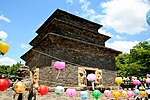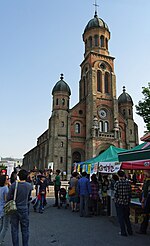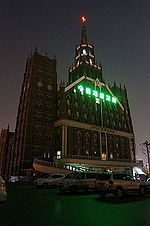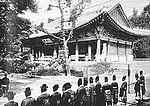Religion in South Korea
Religion in South Korea (2005 census)[1]

Religion in South Korea is characterized by the fact that almost half (46.5%) of South Koreans have no religion; among those that follow a formal religion, there is a dominance of Buddhism, Protestantism, and Roman Catholicism. According to the census of the year 2005, 22.8% of the population identifies as Buddhist, 18.3% as Protestant and 10.9% as Roman Catholic, totaling a 29.2% Christian population.[1] These three denominations have grown rapidly in influence only by the mid-20th century, as part of the profound transformations that the South Korean society has gone through in the past century.[2]
Korea entered the 20th century with almost the totality of its population believing in the native shamanic religion and practicing Confucian rites and ancestral worship.[2] Korean Buddhism, despite its long history and cultural influence, at the dawn of the 20th century was moribund, reduced to a tiny minority after 500 years of suppression by the strictly Neo-Confucian Joseon kingdom,[2] which also disregarded traditional cults.[3] Communities of Christians already existed prior to the 1880s, when the crumbling Joseon state and its intelligentsia endorsed a large influx of Catholic and especially Protestant missionaries from the West.[4] The King of Korea himself and his family tacitly supported Christianity.[5] During World War II the already formed link of Christianity with Korean nationalism was strengthened.[6]
With the division of Korea into two states in 1945, the communist north and the anti-communist south, the bulk of the Korean Christian population that had been until then in the northern half of the peninsula,[7] fled to South Korea.[8] Throughout the second half of the 20th century, the South Korean state enacted measures to defeat the worship of gods which facilitated the spread of Christianity and Buddhism.[9] According to scholars, South Korean censuses do not count believers in Korean shamanism and underestimate the number of adherents of shamanic-derived folk religions.[10] For instance, statistics compiled by the ARDA[11] estimate that as of 2010, 14.7% of South Koreans practice ethnic religion, 14.2% adhere to new movements, and 10.9% practice Confucianism.[12]
Demographics

| Religion | 1950-1962[14] | 1970-1985 | 1995 | 2005[1] |
|---|---|---|---|---|
| Christianity[15] | 5-8% | 18-20.6% | 26.3% | 29.2% |
| Protestantism | 2.8% | 16% | 19.7% | 18.3% |
| Catholic Church | 2.2% | 4.6% | 6.6% | 10.9% |
| Korean Buddhism | 2.6% | 19.2% | 23.2% | 22.8% |
| Other | 92.4% | 2.1% | 1.2% | 1% |
| None | 57.4% | 49.3% | 46.9% |
| Province | Buddhist | Protestant | Catholic | None or other |
|---|---|---|---|---|
| Seoul | 16.8% | 22.8% | 14.2% | 46.2% |
| Busan | 39.2% | 10.4% | 7.4% | 43% |
| Daegu | 33.4% | 10.4% | 9.8% | 46.4% |
| Incheon | 13.8% | 22.4% | 13.7% | 50.1% |
| Gwangju | 14.4% | 19.7% | 13% | 52.9% |
| Daejeon | 21.8% | 20.5% | 10.7% | 47% |
| Gyeonggi Province | 16.8% | 21.9% | 12.4% | 51.1% |
| Gangwon Province | 23% | 15.6% | 9.1% | 52.3% |
| North Chungcheong Province | 23.8% | 15.1% | 9.9% | 51.2% |
| South Chungcheong Province | 20.5% | 19.6% | 9.1% | 50.8% |
| North Jeolla Province | 12.8% | 26.3% | 11.4% | 49.5% |
| South Jeolla Province | 16.1% | 21.8% | 8.7% | 53.4% |
| North Gyeongsang Province | 33.9% | 11.5% | 7.1% | 47.5% |
| South Gyeongsang Province | 40% | 8.8% | 6% | 45.2% |
| Jeju Province | 32.7% | 10.3% | 7.2% | 49.8% |
| South Korea | 22.8% | 18.3% | 10.9% | 46.5% |
| School | Temples |
| Jogye Order (조계종) | 735 (81%) |
| Cheontae Order (천태종) | 144 (16%) |
| Taego Order (태고종) | 102 (11%) |
| Beobhwa Order (법화종) | 22 (2%) |
| Seonhag-won (선학원) | 16 (2%) |
| Wonhyo Order (원효종) | 5 (1%) |
| Other | 27 (3%) |
History
Ancient Korea
Prior to the introduction of Buddhism, all Koreans believed in their indigenous religion socially guided by mu (shamans). Buddhism was introduced from the Chinese Former Qin state in 372 to the northern Korean state of Goguryeo[18][failed verification] and developed into distinctive Korean forms. At that time, the peninsula was divided into three kingdoms: the aforementioned Goguryeo in the north, Baekje in the southwest, and Silla in the southeast. Buddhism reached Silla only in the 5th century, but it was made the state religion only in that kingdom in the year 552.[18] Buddhism became much more popular in Silla and even in Baekje (both areas comprehended in modern South Korea), while in Goguryeo the Korean indigenous religion remained dominant.
In the following unified state of Goryeo (918–1392) Buddhism flourished, and even became a political force.[19] However, in the same period, influences from Chinese Confucianism led to the formation of Korean Confucianism that would have become the state ideology and religion of the following Joseon state.[citation needed]
The Joseon kingdom (1392–1910), strictly Neo-Confucian, harshly suppressed Korean Buddhism[20][21] and Korean shamanism.[3] Buddhist monasteries were destroyed and their number dropped from several hundreds to a mere thirty-six; Buddhism was eradicated from the life of towns as monks and nuns were prohibited from entering them and were marginalised to the mountains.[21] These restrictions lasted until the 19th century.[22]
In the late 19th century, the Joseon state was politically and culturally collapsing.[23] Interested parties were looking for solutions to invigorate and transform the nation.[23] It was in this critical period that they came into contact with Western Protestant missionaries who offered a proven way to use religious beliefs and their system of fears for shaping a citizenship that is obedient to religious and other leaderships.[23] Christian communities already existed in Joseon, however it was only by the 1880s that the government allowed a large number of Western missionaries to enter the country.[24] Protestant missionaries set up schools, hospitals and publishing agencies.[25] The king of Korea and his family tacitly supported Christianity.[5]
During the absorption of Korea into the Japanese Empire (1910–1945) the already formed link of Christianity with Korean nationalism was strengthened,[6] as the Japanese tried to impose State Shinto and Christians refused to take part in Shinto rituals.[6] At the same time, numerous religious movements that since the 19th century had been trying to reform the Korean indigenous religion, notably Cheondoism, flourished.[26]
1945 onwards—South Korea

With the division of Korea into two states in 1945, the communist north and the anti-communist south, the bulk of the Korean Christian population that had been until then in the northern half of the peninsula,[7] fled to South Korea.[8] Cheondoists, who were concentrated in the north like Christians, remained there after the partition,[26] and South Korea now has no more than few thousands Cheondoists.
The so-called "movement to defeat the worship of gods" promoted by governments of South Korea in the 1970s and 1980s, prohibited indigenous worship and wiped out nearly all traditional shrines (sadang 사당) of the Confucian system of kinship gods' worship.[27] This was particularly tough under the rule of Park Chung-hee.[28]
This measures, combined with the rapid social changes of the same period,[2] favoured a rapid revival of Korean Buddhism and growth of Christian churches in a trend to adhere to organised religions.[29] The number of Buddhist temples rose from 2.306 in 1962 to 11.561 in 1997, Protestant churches rose from 6.785 in 1962 to 58.046 in 1997, the Catholic Church had 313 churches in 1965 and 1.366 in 2005, Won Buddhism had 131 temples in 1969 and 418 in 1997.[30] Similarly, Daesun Jinrihoe's number of temples has grown from 700 in 1983 to 1.600 in 1994.[31] Statistics from censuses show that the proportion of the South Korean population self-identifying as Buddhist has grown from 2.6% in 1962 to 22.8% in 2005,[2] while the proportion of Christians has grown from 5% in 1962 to 29.2% in 2005.[2]
Protestant attacks on Buddhism and other traditional religions
Since the 1980s and the 1990s there have been events of hostility of Protestants against Buddhists and followers of traditional religions in South Korea. This include the arson of temples, the beheading of statues of Buddha and bodhisattvas, and red Christian crosses painted on either statues or other Buddhist and other religions' properties.[32] Some of these acts have even been promoted by churches' pastors.[32]
Main religions
Buddhism
Buddhism (불교 Bulgyo) entered Korea from China during the period of the three kingdoms (372, or the 4th century).[18] Buddhism was the dominant religious and cultural influence in the Silla (668-935) and subsequent Goryeo (918-1392) states. Confucianism was also brought to Korea from China in early centuries, and was formulated as Korean Confucianism in Goryeo. However, it was only in the subsequent Joseon kingdom (1392–1910) that Korean Confucianism was established as the state ideology and religion, and Korean Buddhism underwent 500 years of suppression.[20][21] Buddhism in the contemporary state of South Korea is stronger in the east of the country, namely the Yeongnam and Gangwon regions, as well as in Jeju.
There are a number of different schools in Korean Buddhism (대한불교 Daehanbulgyo), including the Seon (Korean Zen). The overwhelming majority of Buddhist temples in contemporary South Korea belong to the Jogye Order, traditionally related to the Seon school. The order's headquarters are at Jogyesa in central Seoul, and it operates most of the country's old and famous temples, such as Bulguksa and Beomeosa.
Buddhism in South Korea is dominated by the Jogye Order, a syncretic sect traditionally linked to the Seon tradition. Most of the country's old and famous temples, such as Bulguksa and Beomeosa, are operated by the Jogye Order, which is headquartered at Jogyesa in central Seoul. Other Buddhist traditions in South Korea include the "Taego" and "Cheontae" lineages. Taego is a form of Seon (Zen), while the Choentae is a modern revival of the Tiantai lineage in Korea, focusing on the Lotus Sutra. Another lineage, the Jingak, is a form of Vajrayana Buddhism. Both the Jogye and Cheontae orders require their monastics to be celibate, while the Taego and Jingak orders allow for married priests. There are many other small orders in South Korea as yet unknown in the West.[citation needed]
Won Buddhism
Won Buddhism (원불교 Wonbulgyo) is a modernly reformed Buddhism that seeks to make enlightenment possible for everyone and applicable to regular life. The scriptures and practices are simplified so that anyone, regardless of their wealth, occupation, or other external living conditions, can understand them.[33]
Christianity
Christianity (기독교 Gidoggyo) in South Korea is predominantly constituted by communities pertaining to Protestantism (개신교 Gaesingyo, "renewed teaching") and Catholicism (천주교 Cheonjugyo, "religion of the Lord of Heaven", or 가톨릭교 Gatolliggyo), respectively with 8.6 million and 5.3 million members as of the 2005 census. There are also small communities of Orthodox Christians (정교회 Jeonggyohoe), founded by Russian Orthodox missionary endeavors in the 19th century, and Mormons (모르몬교 Molmongyo).
Foreign Roman Catholic missionaries did not arrive in Korea until 1794, a decade after the return of Yi Sung-hun, a diplomat who was the first baptised Korean in Beijing.[34] He established a grassroots lay Catholic movement in Korea. However, the writings of the Jesuit missionary Matteo Ricci, who was resident at the imperial court in Beijing, had been already brought to Korea from China in the 17th century. Scholars of the Silhak ("Practical Learning"), were attracted to Catholic doctrines, and this was a key factor for the spread of the Catholic faith in the 1790s.[35] The penetration of Western ideas and Christianity in Korea became known as Seohak ("Western Learning"). A study of 1801 found that more than half of the families that had converted to Catholicism were linked to the Silhak school.[36] Largely because converts refused to perform Confucian ancestral rituals, the Joseon government prohibited the proselytisation of Christianity. Some Catholics were executed during the early 19th century, but the restrictive law was not strictly enforced.
Protestant missionaries entered Korea during the 1880s and, along with Catholic priests, converted a remarkable number of Koreans this time with the tacit support of the royal government.[5] Methodist and Presbyterian missionaries were especially successful. They established schools, universities, hospitals, and orphanages and played a significant role in the modernisation of the country.[25] During the Japanese colonial occupation, Christians were in the front ranks of the struggle for independence. Factors contributing to the growth of Protestantism included the decayed state of Korean Buddhism, the support of the intellectual elite, and the encouragement of self-support and self-government among members of the Korean church, and finally the identification of Christianity with Korean nationalism.[5]
A large number of Christians lived in the northern part of the peninsula (it was part of the so-called "Manchurian revival")[5] where Confucian influence was not as strong as in the south.[7] Before 1948 Pyongyang was an important Christian center: one-sixth of its population of about 300,000 people were converts. Following the establishment of the communist regime in the north, however, most Christians fled to South Korea to escape persecution.[8]
Christianity grew exponentially in the 1970s and 1980s. In the 1990s it continued to grow, but at a slower rate. Christianity is especially dominant in the west of the country including Seoul, Incheon, Gyeonggi and Honam regions. Seoul is home to Yoido Full Gospel Church, the largest Pentecostal megachurch in the country.[citation needed]
The Christian faith in South Korea is heavily dominated by four denominations: Presbyterianism (장로교 pronounced Jangnogyo), Methodism (감리교 pronounced Gamnigyo), Baptists (침례교 pronounced Chimnyegyo) and Catholicism. Some non-denominational churches also exist. Korean Catholics still observe jesa (ancestral rites), albeit in a form that is very different from the religious ancestral worship of ancient Korea that is still practiced nowadays in China and Japan. Protestants, by contrast, have completely abandoned the practice.[37]
The peace churches have not gained a strong foothold on the peninsula. Quaker thought briefly attracted a national following in the late 20th century, thanks to the leadership of Ham Seok-heon. However, after Ham's death, interest in Quakerism declined. The state of Unitarianism is similar.
Mormonism
The Church of Jesus Christ of Latter-day Saints in South Korea was established following the baptism of Kim Ho Jik in 1951. Studying nutrition in Cornell, he met a member of their faith, Oliver Wyman, and was struck with their doctrine. Upon joining the church and completing his degree, Kim traveled back to South Korea, started translations for materials, and helped the church gain official recognition.[38]
As of 2012 there were 81,628 Mormons and one temple in Seoul,[39] four missions (Seoul, Daejeon, Busan, and Seoul South),[40] 128 congregations, and twenty-four family history centres.[41]
It is said that only about 11% of Koreans are Catholic, but in comparison to the United States of America, Catholics in South Korea have been in favor of Pope Francis with a poll of 86% in favor (in comparison to the 66% in the United States of America).[42]
Indigenous religions
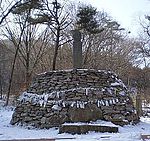
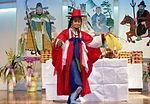
Korean shamanism
Korean shamanism, also known as "Muism" (무교 Mugyo, "mu [shaman] religion")[43] or "Sinism" (신교 Singyo, "religion of the shin (Hanja: 神) [gods]"),[44] is the ethnic religion of Korea and the Koreans.[45] Although used synonymously, the two terms aren't identical:[45] Jung Young Lee describes Muism as a form of Sinism - the shamanic tradition within the religion.[46] Other names for the religion are "Sindo" (신도 "Way of the Gods") or "Sindoism" (신도교 Sindogyo, "religion of the Way of the Gods").[47][note 1]
In contemporary Korean language the shaman-priest or mu (Hanja: 巫) is known as a mudang (Template:Hangul Hanja: 巫堂) if female or baksu if male, although other names and locutions are used.[45][note 2] Korean mu "shaman" is synonymous with Chinese wu, which defines priests both male and female.[46] The role of the mudang is to act as intermediary between the spirits or gods, and the human plain, through gut (rituals), seeking to resolve problems in the patterns of development of human life.[49]
Central to the faith is the belief in Haneullim or Hwanin, meaning "source of all being",[50] and of all gods of nature,[46] the utmost god or the supreme mind.[51] The mu are mythically described as descendants of the "Heavenly King", son of the "Holy Mother [of the Heavenly King]", with investiture often passed down through female princely lineage.[52] However, other myths link the heritage of the traditional faith to Dangun, male son of the Heavenly King and initiator of the Korean nation.[53]
Korean Muism has similarities with Chinese Wuism,[54] Japanese Shinto, and with the Siberian, Mongolian, and Manchurian religious traditions.[54] As highlighted by anthropological studies, the Korean ancestral god Dangun is related to the Ural-Altaic Tengri "Heaven", the shaman and the prince.[55][56] In some provinces of Korea the shaman is still called dangul dangul-ari.[50] The mudang is similar to the Japanese miko and the Ryukyuan yuta. Muism has exerted an influence on some Korean new religions, such as Cheondoism and Jeungsanism. According to various sociological studies, many Christian churches in Korea make use of practices rooted in shamanism.[57]
In the 1890s, the twilight years of the Joseon kingdom, Protestant missionaries gained significant influence, and led a demonisation of the traditional religion through the press, and even carried out campaigns of physical suppression of local cults.[58] The Protestant discourse would have had an influence on all further attempts to uproot Muism.[58]
The movement to destroy the worship of gods in South Korea in the 1970s and 1980s, destroyed much of the physical heritage of Korean indigenous religion (temples and shrines).[27] This was particularly difficult under the regime of President Park Chung-hee.[28][59][60] There has been of a revival of shamanism in South Korea in most recent times.[61][62]
Cheondoism
Cheondoism (천도교 Cheondogyo) is a fundamentally Confucian religious tradition derived from indigenous Sinism. It is the religious dimension of the Donghak ("Eastern Learning") movement that was founded by Choe Je-u (1824-1864), a member of an impoverished yangban (aristocratic) family,[63] in 1860 as a counter-force to the rise of "foreign religions",[64] which in his view included Buddhism and Christianity (part of Seohak, the wave of Western influence that penetrated Korean life at the end of the 19th century).[64] Choe Je-u founded Cheondoism after having been allegedly healed from illness by an experience of Sangje or Haneullim, the god of the universal Heaven in traditional shamanism.[64]
The Donghak movement became so influential among common people that in 1864 the Joseon government sentenced Choe Je-u to death.[64] The movement grew and in 1894 the members gave rise to the Donghak Peasant Revolution against the royal government. With the division of Korea in 1945, most of the Cheondoist community remained in the north, where the majority of them dwelled.[26] Only few thousands of them remain in South Korea today.
The social and historical significance of the Donghak movement and Cheondoism has been largely ignored in South Korea,[65] contrarywise to North Korea where Cheondoism is viewed positively as a folk (minjung) movement.[65]
Other sects
Apart from Cheondoism, other sects based on indigenous religion were founded between the end of the 19th century and the early decades of the 20th century. They include Daejongism (대종교 Daejonggyo),[66] which has as its central creed the worship of Dangun, legendary founder of Gojoseon, thought of as the first proto-Korean kingdom; and two splinter sects of Cheondoism: Suwunism and Bocheonism.[citation needed]
Jeungsanism (증산교 Jeungsangyo) defines a family of religions founded in the early 20th century[67] that emphasise magical practices and millenarian teachings. Part of it are three or possibly more "Jeungsan religions": Jeungsando (증산도) that is the most popular and also proselytises overseas,[68] Taegeukdo (태극도) and Daesun Jinrihoe (대순진리회). They show Taoist-derived themes.[citation needed]
There are also a number of small religious sects, which have sprung up around Gyeryongsan ("Rooster-Dragon Mountain", always one of Korea's most-sacred areas) in South Chungcheong Province, the supposed future site of the founding of a new dynasty originally prophesied in the 18th century (or before). The Chinese religion of Yiguandao (一貫道, Korean: Ilguando) and Japanese Tenriism (천리교 Cheonligyo) also claim to have thousands of South Korean members.[69]
Other religions
Confucianism
Only 0.2% of contemporary South Koreans identify as adherents of Confucianism (유교 Yugyo). However, the influence of Confucian ethical thought on other religious practices, and on Korean culture in general, remains ubiquitous and pervasive.
Confucian rituals are still practiced at various times of the year. The most prominent of these are the annual rites held at the Shrine of Confucius in Seoul. Other rites, for instance those in honor of clan founders, are held at the numerous shrines found throughout the country.
Unification Church
The Unification Church or Unificationism (통일교 Tongilgyo)[70] is a new religious movement founded in South Korea in 1954 by Sun Myung Moon. Since its founding, the church has expanded throughout the world with most members living in East Asia.
Unificationist beliefs are derived from the Christian Bible and are explained in the church's textbook, the Divine Principle. It teaches that God is the creator and Heavenly Father, whose dual nature combines both masculinity and femininity and whose center is true love. The blessing ceremony of the Unification Church, a wedding or marriage rededication ceremony, is a church tradition which has attracted wide public attention.[citation needed]
The Unification Church has sponsored many organizations and projects over the years; including businesses, news media, projects in education and the arts, and political and social activism. The church was led by Moon until his death on September 3, 2012. At the time of Moon's death, it was reported that his widow Hak Ja Han would assume the leadership of the church. Their philosophy for establishing the Kingdom of Heaven is family-centered.[71]
In 2003, Korean Unification Church members started a political party in South Korea. It was named "The Party for God, Peace, Unification, and Home". In an inauguration declaration, the new party said it would focus on preparing for the reunification of the South and North Korea by educating the public about God and peace. A church official said that similar political parties would be started in Japan and the United States.[72]

Islam
Islam (이슬람교 Iseullamgyo) in South Korea is represented by a community of roughly 40,000 Muslims, mainly composed by people who converted during the Korean War and their descendants and not including migrant workers from South and Southeast Asia. The largest mosque is the Seoul Central Mosque in the Itaewon district of Seoul; smaller mosques can be found in most of the country's major cities.
In addition to native Korean Muslims, there are around a hundred thousand foreign workers from Muslim countries, particularly Indonesians, Malaysians, and Pakistanis.[73]
Hinduism
Hinduism (힌두교 Hindugyo) is practiced among South Korea's small Indian and Nepali immigrant community. However, Hindu traditions such as yoga and Vedanta have attracted interest among younger South Koreans. There are two Hindu temples in the Seoul region, the Sri Radha Shyamasundar Mandir and the Sri Sri Radha Krishna temple, located on Seoul's outskirts.
Judaism
The Jewish existence in South Korea effectively began with the dawn of the Korean War in 1950. At this time a large number of Jewish soldiers, including the chaplain Chaim Potok, came to the Korean peninsula. Today the Jewish community is very small and limited to the Seoul Capital Area. There have been very few Korean converts to Judaism (유태교 Yutaegyo).
New religious Movements
According to an article, "Characteristics of Religious Life in South Korea: A Sociological Survey," there was a rise of new religious movements in the late 1900's which has been claimed to be about 10 percent of all churches within South Korea. It has been speculated that this had occurred due to the foreign invasion of countries for the land of South Korea in addition to conflicting views within the country in regards to social and political issues. Within the new religious movements, many of them are syncretic which is combination of beliefs of multiple religions.[74]
Religious Hostility
According to a report by the Pew research center, it had been shown that the South Korean government had low levels of restrictions in addition to the low social hostility of religion. In comparison to the United States of America, South Korea's government restrictions were as low as 1.8 in Pew Research index while the United States had a restriction index of 3.7 (which is double the index of South Korea). Social hostility in South Korea is significantly lower than the United States of America as the index amounts to 0.3 while the United States of America is 1.9 (scales were based on a 1 to 10 ratio).[75]
Religious Restrictions 2012 [76]
| Social Hostilities Index | 0.3 | S.Korea |
|---|---|---|
| 1.9 | USA | |
| 2.9 | Asia-Pacific |
| Government Restriction Index | 1.8 | S. Korea |
| 3.7 | USA | |
| 3.5 | Asia-Pacific |
See also
Footnotes
- ^ Cognates of Japanese Shinto and Chinese Shendao.
- ^ Another term is dangol (Template:Hangul). The word mudang is mostly associated, though not exclusively, to female shamans due to their prevalence in the Korean tradition in recent centuries. This has brought to the development of other locutions for male shamans, including sana mudang (literally "male mudang") in the Seoul area or baksu mudang ("healer mudang"), shortened baksu, in the Pyongyang area. It is reasonable to believe that the word baksu is an ancient authentic designation for male shamans.[48]
References
- ^ a b c 2005 South Korea Census religion statistics. Reported in: Baker, 2008. p. 4
- ^ a b c d e f Pyong Gap Min, 2014.
- ^ a b Joon-sik Choi, 2006. p. 15
- ^ Grayson, 2002. pp. 155-157
- ^ a b c d e Grayson, 2002. p. 158
- ^ a b c Grayson, 2002. pp. 158-161
- ^ a b c Grayson, 2002. p. 158, p. 162
- ^ a b c Grayson, 2002. p. 163
- ^ Kendall, 2010. pp. 4-17
- ^ Baker, 2008. pp. 4-5
- ^ "Quality Data on Religion". The Association of Religion Data Archives. Retrieved 28 January 2016.
- ^ "The Republic of South Korea: Religious Adherents, 2010 (World Christian Database)". Association of Religion Data Archives. Retrieved 27 January 2016.
- ^ a b c "2005 Census of South Korea - Religion Results by Province". sisapress.com.
- ^ 1962 South Korea Census. Data recorded in: Pyong Gap Min, Development of Protestantism in South Korea: Positive and Negative Elements. Published on: Asian American Theological Forum (AATF), 2014, VOL. 1 NO. 3, ISSN 2374-8133
- ^ World Religion Database: Christianity in South Korea 1950-2014
- ^ 안동근현대사 [Andong National: Modern and Contemporary history] (PDF). andong.go.kr (in Korean). 15 December 2010. p. 228. Archived from the original (PDF) on 10 December 2014.
문화관광부의 2005년 5월 자료에 따르면 우리나라에는 907개의 사찰이 있는데, 이를 종단별로 보면, 대한불교조계종 735개소(81%), 한국불교태 고종 102개소(11%), 대한불교법화종 22개소(2%), 선학원 16개소(2%), 대한불교원효종 5개소(1%), 기타 27개소(3%) 순이다.
{{cite web}}: Unknown parameter|deadurl=ignored (|url-status=suggested) (help) - ^ At Korean Wikipedia
- ^ a b c Asia For Educators: Korea, 300 to 600 CE. Columbia University, 2009.
- ^ Vermeersch, Sem. (2008). The Power of the Buddhas: the Politics of Buddhism during the Koryŏ Dynasty (918-1392). p. 3
- ^ a b Grayson, 2002. pp. 120-138
- ^ a b c Tudor, 2012.
- ^ Grayson, 2002. p. 137
- ^ a b c Grayson, 2002. p. 155
- ^ Grayson, 2002. p. 157
- ^ a b Grayson, 2002. pp. 157-158
- ^ a b c Carl Young. Into the Sunset: Ch’ŏndogyo in North Korea, 1945–1950. On: Journal of Korean Religions, Volume 4, Number 2, October 2013. pp. 51-66 / 10.1353/jkr.2013.0010
- ^ a b Kendall, 2010. p. 10
- ^ a b Joon-sik Choi, 2006. p. 17
- ^ Baker, 2008. p. 4
- ^ Baker, 2008. p. 3
- ^ Baker, 2003. p. 5
- ^ a b Buswell, Lee. 2007. p. 375
- ^ Pye, Michael. "Won Buddhism as a Korean New Religion". Numen. 49 (2): 113–141. doi:10.1163/156852702760186745. JSTOR 3270479.
{{cite journal}}: Unknown parameter|subscription=ignored (|url-access=suggested) (help) - ^ Choi Suk-woo. Korean Catholicism Yesterday and Today. On: Korean Journal XXIV, 8, August 1984. pp. 5-6
- ^ Kim Han-sik. The Influence of Christianity. On: Korean Journal XXIII, 12, December 1983. pp. 5-7
- ^ Kim Ok-hy. Women in the History of Catholicism in Korea. On: Korean Journal XXIV, 8, August 1984. p. 30
- ^ Kwon, Okyun (2003). Buddhist and protestant Korean immigrants: religious beliefs and socioeconomic aspects of life. LFB Scholarly Publishing LLC. pp. 137–138. ISBN 978-1-931202-65-7.
- ^ "Kim Ho Jik: Korean Pioneer". The Ensign. July 1988. Retrieved 7 July 2013.
- ^ "Seoul Korea". Lds.org. 2012-02-21. Retrieved 2013-03-13.
- ^ "LDS Church announces creation of 58 new missions". Deseret News. 22 February 2013. Retrieved 7 July 2013.
- ^ "Facts and Statistics, South Korea". LDS Newsroom. 31 December 2012. Retrieved 7 July 2013.
- ^ http://www.pewresearch.org/fact-tank/2014/08/12/6-facts-about-christianity-in-south-korea/
- ^ Used in: Chang Soo-kyung, Kim Tae-gon. Korean Shamanism – Muism. Jimoondang, 1998.
- ^ Used in: Margaret Stutley. Shamanism: A Concise Introduction. Routledge, 2003.
- ^ a b c Jung Young Lee, 1981. p. 4
- ^ a b c Jung Young Lee, 1981. p. 5
- ^ Lee Chi-ran, p. 13
- ^ Jung Young Lee, 1981. pp. 3-4
- ^ Joon-sik Choi, 2006. p. 21
- ^ a b Jung Young Lee, 1981. p. 18
- ^ Jung Young Lee, 1981. p. 17
- ^ Jung Young Lee, 1981. pp. 5-12
- ^ Jung Young Lee, 1981. p. 13
- ^ a b Jung Young Lee, 1981. p. 21
- ^ Sorensen, p. 19-20
- ^ Jung Young Lee, 1981. pp. 17-18
- ^ Andrew E. Kim (2000). "Korean Religious Culture and Its Affinity to Christianity" (PDF). Korea University, Sociology of Religion. Retrieved 28 January 2016.
{{cite web}}: Unknown parameter|registration=ignored (|url-access=suggested) (help) - ^ a b Kendall, 2010. pp. 4-7
- ^ http://www.koreana.or.kr/months/news_view.asp?b_idx=2244&lang=en&page_type=list
- ^ http://www.koreana.or.kr/months/news_view.asp?b_idx=2243&lang=en&page_type=list
- ^ Joon-sik Choi, 2006. pp. 17-18-19
- ^ Sang-Hun, Choe (6 July 2007). "In the age of the Internet, Korean shamans regain popularity". New York Times.
- ^ Lee, 1996. p. 109
- ^ a b c d Lee, 1996. p. 105
- ^ a b Lee, 1996. p. 110
- ^ Baker, 2008. p. 118
- ^ Baker, 2008. p. 85
- ^ Baker, 2008. p. 986
- ^ Baker, 2008. p. 93
- ^ Matczak, Sebastian (1982). Unificationism: A New Philosophy and Worldview. New York, NY: New York Learned Publications.
- ^ Moon, Sun Myung (2013). True Families: Gateway To Heaven. 4 West 43rd Street New York, NY: HSA-UWC. p. 37. ISBN 978-1-931166-31-7.
{{cite book}}: CS1 maint: location (link) - ^ "'Moonies' launch political party in S Korea". iol.co.za. Sapa-AFP. 10 March 2003. Retrieved 28 January 2016.
- ^ "Korea's Muslims Mark Ramadan". The Chosun Ilbo. 11 September 2008. Archived from the original on 13 September 2008. Retrieved 9 October 2008.
{{cite web}}: Unknown parameter|deadurl=ignored (|url-status=suggested) (help) - ^ "Characteristics of Religious Life in South Korea: A Sociological Survey". Review of Religious Research. 43. JSTOR 3512000.
- ^ "6 facts about South Korea's growing Christian population". 2014-08-12. Retrieved 2016-09-18.
- ^ http://www.pewresearch.org/files/2014/08/FT_14.08.04_Religion-in-South-Korea_5restrictions200px.png.
{{cite web}}: Missing or empty|title=(help)
Sources
- Daniel Tudor. Korea: The Impossible Country. Tuttle Publishing, 2012. ISBN 0804842523
- Donald L. Baker. Korean Spirituality. University of Hawaii Press, 2008. ISBN 0824832574
- Donald L. Baker. Modernization and Monotheism: How Urbanization and Westernization Have Transformed the Religious Landscape of Korea. University of British Columbia. Published in: Sang-Oak Lee, Gregory K. Iverson, Pathways into Korean Language and Culture: Essays in Honor of Young-key Kim-Renaud. Pajigong Press, Seoul, 2003. pp. 471–507
- James H. Grayson. Korea - A Religious History. Routledge, 2002. ISBN 070071605X
- Joon-sik Choi. Folk-Religion: The Customs in Korea. Ewha Womans University Press, 2006. ISBN 8973006282
- Jung Young Lee. Korean Shamanistic Rituals. Mouton De Gruyter, 1981. ISBN 9027933782
- Laurel Kendall. Shamans, Nostalgias, and the IMF: South Korean Popular Religion in Motion. University of Hawaii Press, 2010. ISBN 0824833988
- Lee Chi-ran. Chief Director, Haedong Younghan Academy. The Emergence of National Religions in Korea.
- Pyong Gap Min, Development of Protestantism in South Korea: Positive and Negative Elements. On: Asian American Theological Forum (AATF) 2014, VOL. 1 NO. 3, ISSN 2374-8133
- Robert E. Buswell, Timothy S. Lee. Christianity in Korea. University of Hawaii Press, 2007. ISBN 082483206X
- Sang Taek Lee. Religion and Social Formation in Korea: Minjung and Millenarianism. Walter de Gruyter & Co, 1996. ISBN 3110147971
- Sorensen, Clark W. University of Washington. The Political Message of Folklore in South Korea's Student Demonstrations of the Eighties: An Approach to the Analysis of Political Theater. Paper presented at the conference "Fifty Years of Korean Independence", sponsored by the Korean Political Science Association, Seoul, Korea, July 1995.
External links
- Sung-Gun Kim. Pentecostalism, Shamanism and Capitalism within Contemporary Korean Society. usc.edu





